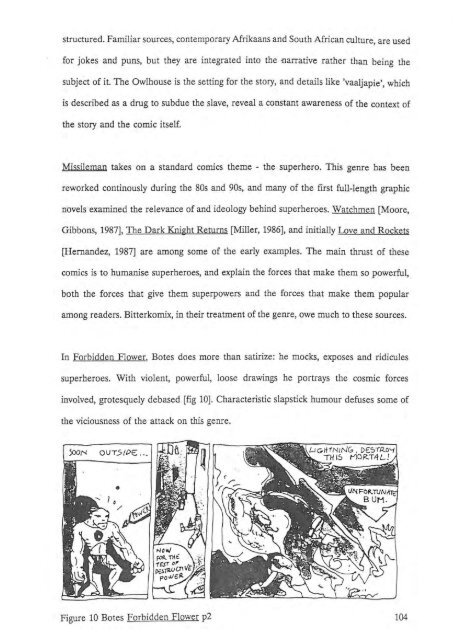Text - Rhodes University
Text - Rhodes University
Text - Rhodes University
Create successful ePaper yourself
Turn your PDF publications into a flip-book with our unique Google optimized e-Paper software.
structured. Familiar sources, contemporary Afrikaans and South African culture, are used<br />
for jokes and puns, but they are integrated into the narrative rather than being the<br />
subject of it. The Owlhouse is the setting for the story, and details like 'vaaljapie', which<br />
is described as a drug to subdue the slave, reveal a constant awareness of the context of<br />
the story and the comic itself.<br />
Missileman takes on a standard comics theme - the superhero. This genre has been<br />
reworked continously during the 80s and 90s, and many of the first full-length graphic<br />
novels examined the relevance of and ideology behind superheroes. Watchmen [Moore,<br />
Gibbons, 1987], The Dark Knight Returns [Miller, 1986], and initially Love and Rockets<br />
[Hernandez, 1987] are among some of the early examples. The main thrust of these<br />
comics is to humanise superheroes, and explain the forces that make them so powerful,<br />
both the forces that give them superpowers and the forces that make them popular<br />
among readers. Bitterkomix, in their treatment of the genre, owe much to these sources.<br />
In Forbidden Flower, Bates does more than satirize: he mocks, exposes and ridicules<br />
superheroes. With violent, powerful, loose drawings he portrays the cosmic forces<br />
involved, grotesquely debased [fig 10]. Characteristic slapstick humour defuses some of<br />
the viciousness of the attack on this genre.<br />
OUT51()€ ...<br />
•<br />
Figure 10 Bates Forbidden Flower p2 104
















